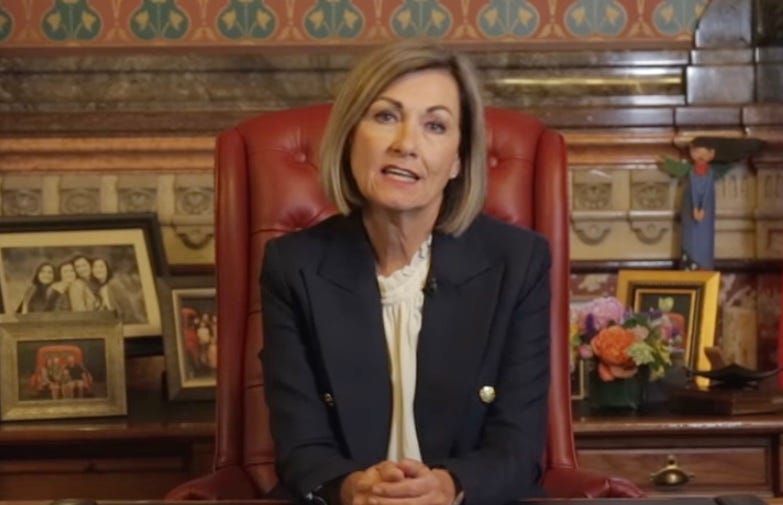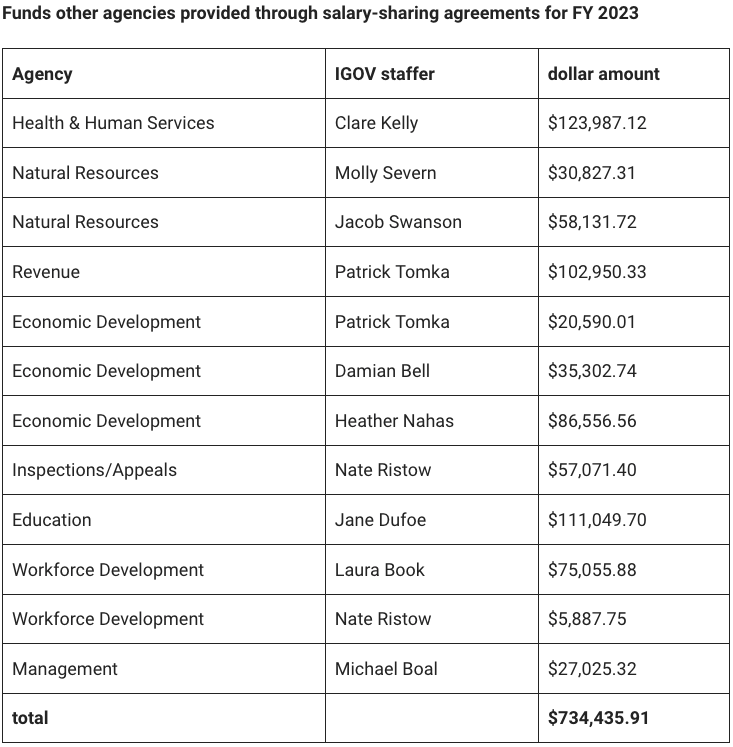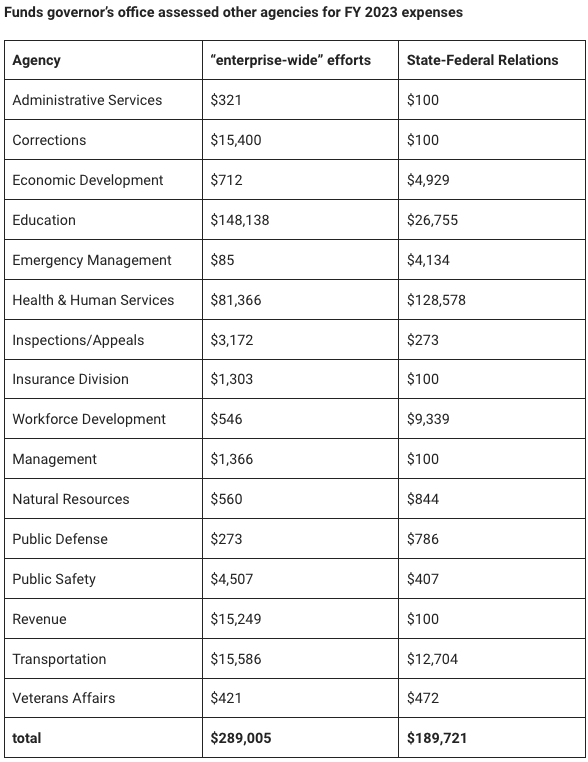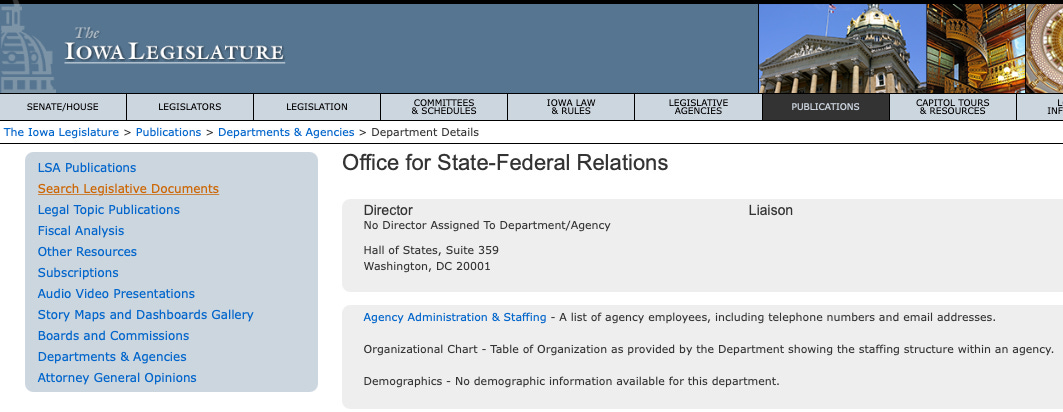Exclusive: Agencies spent $1 million on Iowa governor's office costs last year
Many questions remain about Kim Reynolds' office budget

This investigative reporting and analysis first appeared at Bleeding Heartland and is shared here as part of the Iowa Writers Collaborative. For regular emails linking to all recent Bleeding Heartland articles and commentary, subscribe to the free Evening Heartland newsletter. If your email provider truncates this post, you can read the whole article without interruption at this link.
In March, Governor Kim Reynolds hailed passage of her state government reorganization plan, saying it would be “an important step” to “reduce the size and cost of government.”
The governor’s commitment to making government smaller and less costly hasn’t extended to her own staff.
In the fiscal year that ended June 30, other agencies spent more than $1 million to cover operating costs in the governor’s office, documents Bleeding Heartland obtained through public records requests show. Those funds allowed the governor’s office to spend nearly 50 percent more than its budget appropriation of $2.3 million for fiscal year 2023.
Reynolds’ chief of staff Taryn Frideres told state lawmakers in February that increasing the governor’s office allocation for the current fiscal year by about $500,000 (a 21 percent bump) would be “more transparent” and ensure that “our actual appropriation is closer to our expenses, so that we can budget in a more straightforward way.”
But records Bleeding Heartland reviewed indicate that the $2.8 million general fund appropriation Republicans approved for fiscal year 2024 will fall far short of what the governor’s office will spend on staff salaries and other expenses.
AN ONGOING PRACTICE
While Reynolds has requested status-quo budgets for many state agencies and departments, she has not imposed the same fiscal discipline on her own operation. Using funds from other agencies to pay some governor’s office staff is a longstanding practice in Iowa, but the current governor has expanded its scope.
Reynolds tapped other funding sources, including federal COVID-19 relief funds, to cover at least $891,000 of her office’s expenses in fiscal year 2020, even though the GOP-controlled legislature had just increased the governor’s office budget by nearly 10 percent, from about $2.1 million to $2.3 million.
Then chief of staff Sara Craig Gongol told appropriators in 2019 that the extra $200,000 would fund new analysts to work on health and tax policy. However, the Iowa Department of Human Services and Iowa Department of Revenue ended up covering 100 percent of those staffers’ salaries and benefits through mid-March 2020, and COVID-19 relief funds picked up most of the tab for the remainder of the fiscal year.
Funding provided by various state agencies totaled roughly $900,000 in fiscal year 2021, during which the governor’s office also offloaded the cost of two major technology upgrades, costing more than $107,000 combined.
State officials provided documents to Bleeding Heartland regarding fiscal year 2022 in a different format, which obscured some of the cost shifts. Still, those records revealed that transfers from other state agencies allowed the governor’s office to spend at least $784,000 more than its budget appropriation.
During the 2022 legislative session, Republican lawmakers approved $2,315,344 from the state’s general fund for the governor’s office to spend on “salaries, support, maintenance, and miscellaneous purposes” during fiscal year 2023, which ran from July 1, 2022 through June 30 of this year.
To supplement those funds, Reynolds’ staff employed one traditional tactic and one innovation.
SALARY-SHARING AGREEMENTS: $734,435.91
Since at least the Vilsack administration, Iowa governors have used salary-sharing agreements to pay a portion of personnel costs for staff members who spend a significant amount of time working with one agency. Those agreements are typically called MOUs, which stands for “Memorandum of Understanding” between the agency and the governor’s office.
In response to Bleeding Heartland’s request, the Iowa Department of Management provided copies of invoices the governor’s office sent to eight agencies for work people on Reynolds’ staff did during fiscal year 2023. You can view and download those documents here and here; I put the key information in the following table.

No one agency covered the entirety of any Reynolds staffer’s compensation. Usually, an MOU specifies a percentage, and the agency is responsible for that share of a particular employee’s salary and benefits during the date range.
In addition to the MOUs, the governor’s office found a new way to bring money in during fiscal year 2023 that would not be tied to any one person’s work.
ASSESSMENTS FOR “ENTERPRISE-WIDE” EFFORTS: $289,005
The Department of Management works closely with the governor’s office on state budget planning and monitors disbursements of state and federal funds. For several years, I have requested records from the department related to other agencies covering governor’s office costs.
The batch of documents provided this fall included something I’ve never seen: assessments to sixteen agencies “to support the enterprise-wide efforts of the Governor’s Office.”
The directives came from Department of Management Director Kraig Paulsen in mid-June, about two weeks before the end of the fiscal year. Each one explained to an agency leader,
On behalf of the Governor’s Office, the Department of Management is collecting assessments from all state agencies to support the enterprise-wide efforts of the Governor’s Office and the Office of State-Federal Relations (OSFR) for Fiscal Year 2023.
Assessments collected for the Governor’s Office support the enterprise-wide policy, operational, and communications efforts that benefit all state agencies. The OSFR supports policy engagement in support of state agencies, including with respect to Federal legislation, regulations, grant programs, and coordination with Federal officials.
Why sixteen agencies? That’s the number of cabinet-level departments following the state government reorganizationenacted this year.
The assessments for the Office for State-Federal Relations are nothing new. Based in Washington, DC, that office is charged with tasks such as advocating for federal policies that benefit Iowa, monitoring federal policies, and facilitating relationships between state and federal officials. Iowa doesn’t pay for that work through a general fund appropriation. Rather, state agencies are assessed annually. The largest transfers come from agencies that receive the most federal funding: the Departments of Health and Human Services, Education, and Transportation.
There were some changes related to the Office for State-Federal Relations during fiscal year 2023, which I’ll get to in a moment. What jumped out at me were the assessments for “enterprise-wide efforts.” The governor’s staff have always done some policy work that could be construed as benefiting all state agencies. Yet I’m not aware of a precedent for other agencies to be billed for costs not linked to a particular staff member.
I created this table using dollar amounts the Department of Management assessed the sixteen agencies. For some reason, their own table summed up the charges as $289,004 for general office assessments and $189,722 for the state-federal office. I’ve triple-checked my math.

“TRYING TO TAKE A WHOLE-OF-GOVERNMENT APPROACH”
With hindsight, I see Frideres was building a case for these assessments when she met with members of the Iowa House Administration and Regulation budget subcommittee in February to defend the governor’s request for an extra $500,000 appropriation.
When Democratic State Representative Bob Kressig asked about the priorities for Reynolds’ office, Frideres explained that about 95 percent of the office budget goes toward personnel costs, and “our focus is continuing to recruit and retain senior, experienced staff.”
She said, “Over the last several years, our office has been engaged in more whole-of-government work,” including developing the realignment proposal. She noted that if the legislature approved the governor’s plan (which both chambers did in March), “our office would be responsible with the support of DOM [the Department of Management] in ensuring that it’s implemented seamlessly,” in the most “effective and efficient” way. That would take staff time.
A few minutes later, Frideres told Democratic State Representative Megan Srinivas the governor’s office has “had to work on more cross-cutting issues” across state government since the COVID-19 pandemic. Reynolds’ staff have had to administer more federal funds, plan the government restructuring, and help redesign state agency websites, while also working on a statewide branding initiative. “So we’re really trying to take a whole-of-government approach. Really the governor’s office is the only office that’s placed well to do that.”
Frideres acknowledged the governor’s office has used salary-sharing agreements and assessments “to account for our actual expenditures,” but that approach has “less flexibility,” since staff are tied to working for a single agency. They want more of the governor’s staff “to be thinking state government-wide.”
Assessing agencies for “enterprise-wide” work has some obvious advantages. The governor’s office can generate hundreds of thousands of dollars a year without anyone scrutinizing whether this or that staffer was really putting in the time on one agency’s issues.
AGENCIES CHARGED LESS FOR STATE-FEDERAL OFFICE, BUT MORE OVERALL
According to Iowa law, the Office for State-Federal Relations is an independent agency. Nevertheless, state financial documents list the office as a unit of the governor’s office. So unspent funds from the Office for State-Federal Relations can count as revenue to offset expenses the governor’s staff incurred in Des Moines.
As Bleeding Heartland has previously reported (see here, here, and here), the Office for State-Federal Relations has repeatedly helped the governor’s office balance its books during the Reynolds era.
From 2017 through fiscal year 2022, the funding formula for the state-federal office designated $299,782 in transfers from various state agencies. That sum was supposed to pay for an office with two full-time staff in the nation’s capital. Governors Tom Vilsack, Chet Culver, and Terry Branstad each had two people working for their administrations in Washington, DC.
But records Bleeding Heartland received from the Iowa Department of Administrative Services in 2021 show Reynolds has left one staff position vacant in the Office for State-Federal Relations since she assumed the governor’s powers in the spring of 2017. That practice has generated operating surpluses.
During fiscal year 2020, the Office of State-Federal Relations spent $215,047 of the $299,782 received in transfers, leaving $84,735 in unspent funds to support other governor’s office expenditures. Financial reports I received for fiscal year 2022 showed the state-federal office received transfers from other agencies totaling $299,732, but spent only $184,897, leaving a surplus of $114,835 that could be used to help total revenues match expenditures in the governor’s office budget.
I was intrigued to see that for fiscal year 2023, other agencies were assessed only $189,721 for the state-federal office, as shown in the table above. I don’t yet have documents showing last year’s actual expenses for the DC office; $189,721 could be in the ballpark. In any event, state agencies are no longer being charged to cover a two-person office with only one employee.
On the other hand, as discussed above, other agencies were on the hook for $289,005 to cover the “enterprise-wide” efforts of the governor’s office. So even though agencies collectively saved money on the state-federal office, the overall cost of the assessments went way up in fiscal year 2023.
When the Iowa Senate and House debated the administration and regulation budget for fiscal year 2024, several Democrats criticized the extra $500,000 allocated to the governor’s office. State Senator Janet Petersen, the ranking Democrat on the Senate Appropriations Committee, told Bleeding Heartland this week, “Governor Reynolds gave her office a 21 percent increase, which Iowans are not seeing anywhere else in state government.”
Assessments to supplement the governor’s budget rose even more sharply. Total transfers from other agencies to support the governor’s office ($189,721 for the state-federal office plus $289,005 for general office assessments, or $478,726 total) were nearly 60 percent higher in fiscal year 2023 than what agencies were previously charged for state-federal relations alone ($299,782).
The governor’s office was able to collect those extra funds without legislative approval or the public scrutiny that can accompany the appropriations process.
Adding the $289,005 from “enterprise-wide” assessments to the $734,435.91 received through salary-sharing agreements, we can say that at minimum, $1,023,440.91 flowed from other agencies to support Reynolds’ office expenses from July 2022 through June 2023.
I sought comment on those numbers from State Senator Claire Celsi, the ranking Democrat on the Administration and Regulation Budget Subcommittee, which supervises the governor’s office’s budget. She told me,
Governor Reynolds continues to make her own rules regarding the budget expenditures for her office. Ironically, this is only happening because of the draconian budget cuts she is implementing throughout state government. Not only is she treating her staff preferentially, she’s doing so without any accountability or transparency to Iowans.
A full accounting of state agency support for the governor’s office budget isn’t possible without more detailed financial reports. The sum might be well above $1 million, if other agencies also paid for any goods or services last year, the way the Office of Chief Information Officer covered the costs of a computer software migration and audio/video tech upgradesin the governor’s suite two years ago. (Such payments would not be reflected on the documents I received from the Department of Management.)
It’s also not clear whether the state-federal office spent all of the $189,721 received in assessments for the last fiscal year, or what is going on with that office more broadly.
IS ANYONE HOME AT IOWA’S WASHINGTON, DC OFFICE?
The governor’s office announced in September 2021 that Meaghan O’Brien was replacing Stephanie Groen as “the Governor’s Director of State-Federal Relations, based out of Washington D.C.” Salary records the Department of Administrative Services provided to Bleeding Heartland show O’Brien’s employment with the governor’s office ended in early November 2022, a little more than four months into fiscal year 2023.
A news release from late May 2023 stated, “Eric Baker will now serve as Director of Federal-State Relations while also continuing to serve as Director of Strategic Operations.” Does that mean no one was leading the DC office for nearly seven months following O’Brien’s departure?
The governor’s staff have not responded to several questions I emailed on December 4 about the state-federal relations work.
Were unspent funds assessed for the Office of State-Federal Relations used to keep the governor’s office budget balanced for fiscal year 2023?
Is Eric Baker based in Des Moines or in the Washington, DC area? (His LinkedIn page shows his location as Des Moines.)
Does the state of Iowa still pay for office space in the capital? Iowa Code Chapter 7F.1(3) stipulates that the Office for State-Federal Relations “shall be located in Washington, D.C., and shall be administered by the director of the office […].”
The Iowa legislature’s website gives an address for the Office for State-Federal Relations, but no phone number or name of a director or liaison.
An employee at the company that manages the Hall of States building gave me a phone number for Suite 359, so I called that number during business hours. After a few rings, I heard a recorded message from Groen, who hasn’t led the state-federal relations office since September 2021.
Groen’s message encourages callers to leave a voicemail, but an automated voice said I could not record a message for Doug Hoelscher, because “this mailbox is full.” Hoelscher ran Iowa’s office in Washington during the second Branstad administration, from 2011 to 2017, then landed a job in the Trump White House.
When possible, I will update this post with more information on what is happening with the Office for State-Federal Relations.
FAR FROM SOLVENCY OR TRANSPARENCY
In response to my questions about aspects of the governor’s office spending, Reynolds’ deputy communications director Kollin Crompton described the $500,000 budget increase as “long overdue” in a November 28 email. He asserted the extra funding would bring the office budget “into better alignment with its expenditures.” He also said increasing the appropriation “is a better option” than using salary-sharing agreements, and would allow the governor’s office “to operate more effectively and transparently.”
The current funding scheme for Reynolds’ office could hardly be less transparent. Even after submitting multiple records requests to different agencies (waiting weeks or months for documents each time), I don’t have a full picture of revenues and expenditures for the last fiscal year.
As mentioned above, about 95 percent of governor’s office expenses go toward staff compensation. If the office needed to pull more than $1 million from other agencies to make ends meet during fiscal year 2023, an extra $500,000 for fiscal year 2024 will not close the gap. Aside from Reynolds and Lieutenant Governor Adam Gregg, whose salaries are fixed in Iowa Code, all governor’s office employees received a 3 percent raise at the beginning of July, and some staff received larger raises in September.
A forthcoming Bleeding Heartland post will examine the governor’s office personnel costs for the current fiscal year in more detail.
Final note: Laura Belin is committed to providing in-depth coverage of Iowa politics with no paywall. Readers who would like to support this work financially can become paid subscribers through Substack, or make donations of any amount using a credit card, PayPal, or Venmo. To avoid conflicts of interest, Laura does not accept contributions from Iowa elected officials, candidates, or paid campaign staff or consultants on Iowa campaigns.
I encourage you to check out the work of other Iowa Writers Collaborative columnists.





Terrific reporting, Laura!
Will anything be done about it.? She seems to do most anything she pleases& either no one notices or cares. It really angers me!!!